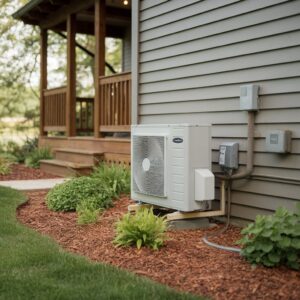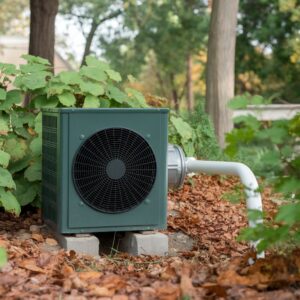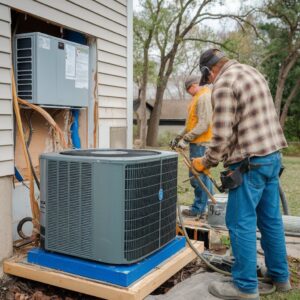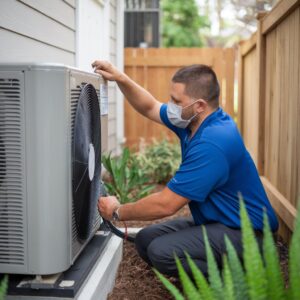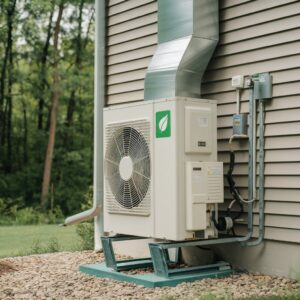Installing a sump pump in a basement involves precise preparation and installation for ideal Drainage. First, professionals recommend evaluating the need for submersible or pedestal pumps, considering the water table and basin size. Key steps include digging a precisely measured pit, securing a sump liner, and efficiently connecting a discharge pipe to channel water away. Testing verifies activation upon water contact. Discover detailed procedures to maintain a reliable long-term drainage system.
Key Takeaways
- Determine the appropriate sump pump type based on basement size and local water table conditions.
- Excavate a pit with precise measurements and fill the bottom with gravel for filtration.
- Securely position the sump liner within the pit for stability and optimal Drainage.
- Connect the sump pump to a discharge pipe directing water away from the house foundation.
- Test the system by activating the pump and ensuring unimpeded water flow through the discharge line.
What Do You Need to Know Before You Install a Sump Pump in Your Basement?
Before installing a sump pump in a basement, it is vital to understand the conditions that necessitate its use, such as frequent flooding or high water tables.
Selecting the appropriate sump pump system requires evaluating capacity, power source, and drainage efficiency to suit specific moisture control needs.
Engaging a professional might be necessary when the installation involves complex plumbing or electrical work beyond typical DIY capabilities.
Why Might You Need a Sump Pump to Keep Your Basement Dry?
How often do homeowners consider the potential risks of water intrusion in their basements?
Basements are particularly vulnerable to rising groundwater and heavy rain, which can lead to increased water levels and subsequent water damage.
A sump pump, strategically placed within a sump pit, is essential in preventing water from infiltrating the basement.
By efficiently managing Drainage, a sump pump system mitigates water intrusion risks by redirecting excess water away from the foundation wall.
This prevents structural compromise and maintains the basement’s integrity.
Effective at addressing fluctuations in groundwater, a sump pump guarantees that the water level remains controlled, thereby safeguarding the basement from moisture-related issues.
Proper installation is critical to maximize efficiency and long-term protection.
How Do You Choose the Right Sump Pump System for Drainage?
Selecting the appropriate sump pump system is paramount for effective basement drainage management. Proper assessment of various factors guarantees peak performance.
- Type of Sump Pump: Consider whether a primary sump pump should be submersible or pedestal. Submersible sump pumps are suitable for larger sump basins, submerged within water, offering quieter operation. Conversely, pedestal sump pumps, with motors above the water line, are ideal for smaller basins.
- Water Table and Sump Basin: Evaluate the local water table and the sump basin size to determine the pump’s capacity. High water tables may require more robust systems.
- Discharge Pipe and Backup Sump Pumps: Confirm that the discharge pipe efficiently channels water away from the foundation.
Incorporate backup sump pumps to maintain functionality during power outages or pump failures.
When Is It Necessary to Hire a Professional Before Installing a Sump Pump?
When should a homeowner consider hiring a professional for sump pump installation?
Homeowners should call a professional if they lack the expertise to install a sump pump, especially when understanding local construction codes is vital. A plumber or contractor can guarantee compliance and correct the installation process.
Complexities arise when selecting the type of pump or determining the best sump pump location. Although one might attempt to learn how to install independently, errors can lead to costly damage.
Hiring a contractor becomes necessary if the basement’s layout presents unique challenges or when dealing with advanced systems like battery backups.
Ultimately, professional sump pump installation provides peace of mind, assuring homeowners of a reliable and efficient system tailored to their needs.
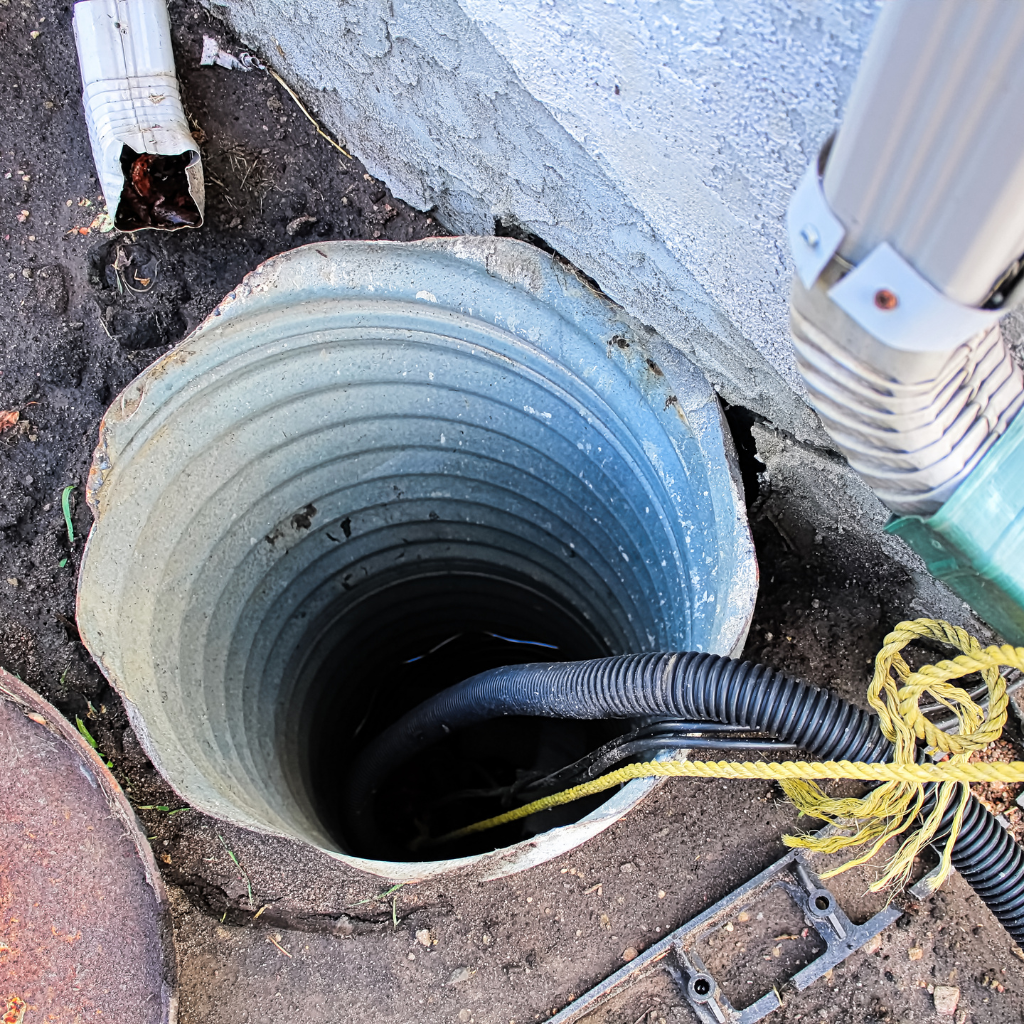
How Do You Prepare a Basement for Sump Pump Installation?
Proper preparation for sump pump installation in a basement involves gathering the necessary tools and materials, such as a jackhammer, PVC pipes, and gravel, before deciding where the sump pump will be installed. Choosing the best sump pump for your basement conditions is also essential, as the sump pump may vary in capacity, design, and type.
Digging the pit requires precise measurements to guarantee ideal Drainage and pump placement. A sump pump typically sits at the lowest point in the basement, ensuring maximum efficiency when redirecting water.
Careful planning of the drainage setup is essential to prevent water accumulation and guarantee efficient water redirection when you install the system in your basement.
What Tools and Materials Are Needed to Install the Sump Pump?
Installing a sump pump in a basement requires specific tools and materials to guarantee a successful and efficient installation process. This preparation guarantees proper management of water accumulation and longevity of the system.
Important components include:
- Tools and Equipment: A power drill is required to drill a hole for the discharge pipe and other necessary fittings.
- A shovel or digging tool is essential to dig a hole in the basement floor for the sump pit.
- Materials: A PVC pipe is required to direct water from the foundation.
- Additionally, a check valve is essential to prevent backflow.
- Sump Pump Components: A submersible sump pump with a float switch is crucial for automatic operation and efficient water removal.
How Do You Dig the Pit and Prepare for a Proper Drainage Setup?
Before commencing a sump pump installation, it is crucial to methodically prepare the basement by digging a pit and setting up an effective drainage system.
Begin by selecting an appropriate location to dig the hole in the concrete floor, guaranteeing proximity to the perimeter drain. The sump pit should be bottomless enough to accommodate the sump liner and wide enough to collect water efficiently.
Once the hole is dug, fill the bottom of the sump pit with gravel to aid in water filtration. Position the sump liner securely within the pit, ensuring stability. This setup will direct water effectively to the sump pump.
Finally, place the pump within the liner, ready for operation. Proper installation guarantees ideal Drainage and basement protection.
How Do You Install a Sump Pump and Connect the Discharge Pipe?
Installing a sump pump in a basement requires precise steps to guarantee it is securely placed in the pit and functions efficiently.
Proper attachment and plumbing of the discharge pipe are critical for adequate water drainage, preventing potential flooding issues.
If the pump’s performance is compromised, sump pump replacement may be the best solution to restore functionality.
In some situations, especially when complex plumbing configurations or local regulations are involved, it may be necessary to engage a professional to complete the installation.
What Are the Steps to Install the Sump Pump Safely in the Basement Pit?
To install a sump pump safely in a basement pit, one must first guarantee that the pit is adequately sized and positioned at the lowest point of the basement floor to collect water effectively.
The homeowner should then proceed to install the sump pump by following these steps:
- Pump into the Pit: Lower the cast-iron basement sump pump into the prepared pit, ensuring it sits securely at the base.
- Hole Saw Use: Utilize a hole saw to create an opening in the pit’s side for the water discharge line, directing it away from the foundation to maintain structural integrity.
- Sump System Connection: Connect the sump pump to the sump system, confirming all components are tightly sealed to prevent leaks.
How Do You Attach and Plumb the Discharge Pipe for Effective Drainage?
Why is it essential to secure the proper attachment and plumbing of the discharge pipe when installing a sump pump?
Correct installation guarantees the sump pump functions efficiently, directing water away from the house to prevent flooding.
After the sump pump is installed, one must plumb and connect the sump to the discharge pipe securely. The discharge pipe should lead water away from the house at a safe distance.
Once connected, plug the sump pump into power, allowing the float to activate and test the pump. This guarantees the pump works effectively and efficiently drives water away.
Proper plumbing of the discharge pipe is vital for operational reliability and longevity, preventing water from re-entering the basement.
When Do You Need a Professional to Finish a Sump Pump Installation?
Although many homeowners opt to install a sump pump themselves, there are circumstances where professional assistance is advisable to ascertain proper functionality and compliance with local construction codes.
A professional is often required when:
- Finished Basement: If the basement is finished, a professional guarantees minimal disruption while installing the sump pump, using specialized tools like a jackhammer to access the floor without unnecessary damage.
- Complex Installations: When a sump pump is needed due to intricate drainage issues or when water reaches challenging areas, professionals can design systems to collect water from around the foundation efficiently.
- Testing and Compliance: Professionals can test the sump pump system, ensuring it meets local construction codes and functions reliably.
Sump pump installation typically requires expertise to mitigate potential issues.

How Do You Test the Sump Pump System After Installation?
Testing the sump pump system post-installation is critical to verify functionality before heavy rains occur.
The primary indicators of a properly working system include the activation of the pump when water is added to the basin and the unimpeded flow of water through the discharge pipe.
Should the basement remain wet despite the installation, inspecting for blockages or pump malfunctions is advisable.
Why Is It Important to Test the Sump Pump System Before Heavy Rain?
Verifying the reliability of a sump pump system before heavy rain is vital to prevent potential flooding and water damage in a basement. Regular testing of the sump pump and alarm guarantees the system’s readiness.
Proper sump pump maintenance is essential for keeping the basement dry and safeguarding the home’s basement or crawlspace. Testing involves checking if the pump installed, particularly submersible pumps, can effectively manage water drainage.
To verify that sump pumps work correctly, homeowners should:
- Inspect the sump pit: Make sure it is free from debris that might obstruct the drain.
- Activate the sump pump: Pour water into the pit until the pump engages.
- Test the sump pump alarm: Confirm it alerts when water levels are high.
How Can You Tell If the Discharge Pipe and Pump Are Working Properly?
How can homeowners confirm that the discharge pipe and pump function at peak performance? Guaranteeing the sump pump and discharge pipe are installed correctly requires a systematic approach.
First, inspect the pump operation by simulating water drainage; pour water into the sump pit until the pump activates. Observe that water efficiently exits through the discharge pipe, whether plastic or metal, and is expelled far from the home.
Verify that the check valve prevents backflow, maintaining water below floor level. Inspect the basement for any residual moisture that could indicate inefficiency.
Regularly examine connections for tight seals and guarantee the discharge pipe remains unobstructed. This procedure safeguards the home from water intrusion and confirms system reliability.
What Should You Do If the Basement Is Not Staying Dry After You Install a Sump Pump?
Despite confirming the proper operation of the sump pump and discharge pipe, homeowners may still encounter issues with basement dryness. In such cases, further investigation is warranted to guarantee effective water management.
- Inspect Crawlspaces: Check for water seepage that may bypass the sump pump. Crawlspaces should be monitored closely, as they can contribute to moisture buildup in an existing home.
- Evaluate Drainage Around the Sump Liner: Ascertain that water is effectively directed to the sump pump. A proper slope can help guide water into the system, enhancing efficiency.
- Consider a Dry Well: For persistent water issues, installing a dry well can provide additional drainage capacity. This is especially useful when HP sump pumps cannot handle the water volume.
A sump pump can help, but additional measures may be necessary.
How Can You Maintain a Sump Pump for Long-Term Basement Drainage?
Proper sump pump maintenance is essential for guaranteeing adequate long-term basement drainage.
Routine inspection and cleaning of the pump and its parts help prevent clogs and mechanical issues.
Testing the system quarterly guarantees that it functions reliably during heavy rainfall or flooding.
Engaging a professional for maintenance and repairs is advisable when encountering persistent issues or complex malfunctions that require specialized expertise.
What Regular Sump Pump Maintenance Helps Keep the Basement Dry?
Maintaining a sump pump in prime condition is critical for adequate long-term basement drainage. Regular maintenance allows water to be efficiently redirected from the basement or crawlspace, guaranteeing the pump works effectively.
A thorough how-to guide can offer precise steps, but the following key tasks are essential:
- Inspect the Discharge Line: Check for clogs or obstructions hindering water flow. This guarantees the pump can work without interruption.
- Clean the Sump Pit: Sediment and debris can accumulate, which could add unnecessary strain on the pump. Regular cleaning prevents blockages and maintains efficiency.
- Test the Pump Operation: A routine check guarantees all components function correctly. This proactive approach identifies problems before they escalate, keeping the basement dry.
How Often Should You Test the Sump Pump System to Prevent Failure?
To maintain effective long-term basement drainage, understanding the frequency of sump pump system testing is pivotal. Regular testing helps avert unexpected failures.
Quarterly assessments are recommended as a standard practice. If the discharge pipe shows signs of backflow, it’s important to address the issue before it escalates into a larger problem. During these inspections, evaluate the pump’s responsiveness by pouring water into the sump pit, confirming that the float switch activates the pump. Monitor discharge lines for obstructions or leaks, validating seamless water ejection.
Additionally, verify the backup power source’s functionality, particularly in systems reliant on battery backups. After heavy rainfall or thawing, supplementary checks confirm resilience under increased operational demand.
Implementing this quarterly regime prolongs the pump’s lifespan and mitigates the risk of basement flooding. Consistent scrutiny guarantees readiness, safeguarding the basement environment from water intrusion.
When Is It Best to Call a Professional for Sump Pump Maintenance and Repairs?
When is it prudent to enlist professional assistance for sump pump maintenance and repairs? Homeowners often face situations where professional intervention is essential to guarantee the longevity and efficiency of their sump pump systems.
Professional assistance should be considered in the following scenarios:
- Persistent Malfunctions: If the sump pump frequently fails to activate or deactivates improperly, this indicates potential electrical or mechanical issues that require professional diagnosis and repair.
- Unusual Noises or Vibrations: Grinding, rattling, or excessive vibrations often signal internal damage, such as a defective impeller or motor bearing issues.
- Significant Water Accumulation: If the basement experiences consistent flooding despite the pump’s operation, this suggests possible drainage system blockages or pump inadequacies that necessitate expert evaluation.
Engaging professionals guarantees the system functions effectively, preventing costly damage.
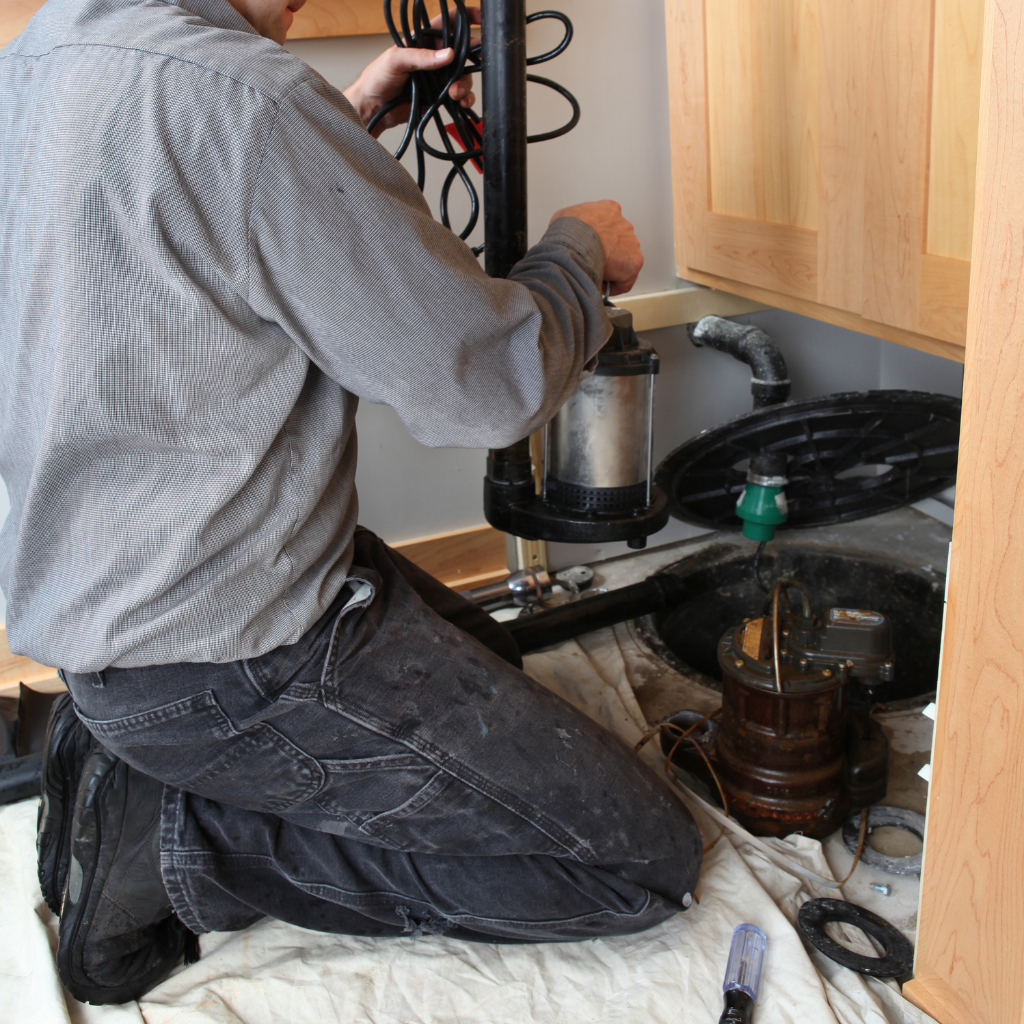
Conclusion
Installing a sump pump in a basement requires careful preparation and precise execution to guarantee adequate Drainage. Familiarity with the necessary tools and techniques is crucial for a successful installation. Critical steps are critical to prepare the site correctly, connect the discharge pipe, and test the system. Regular maintenance and inspection are essential to ensure long-term functionality and prevent potential flooding. By adhering to these guidelines, homeowners can safeguard their basements from water damage efficiently and effectively.

